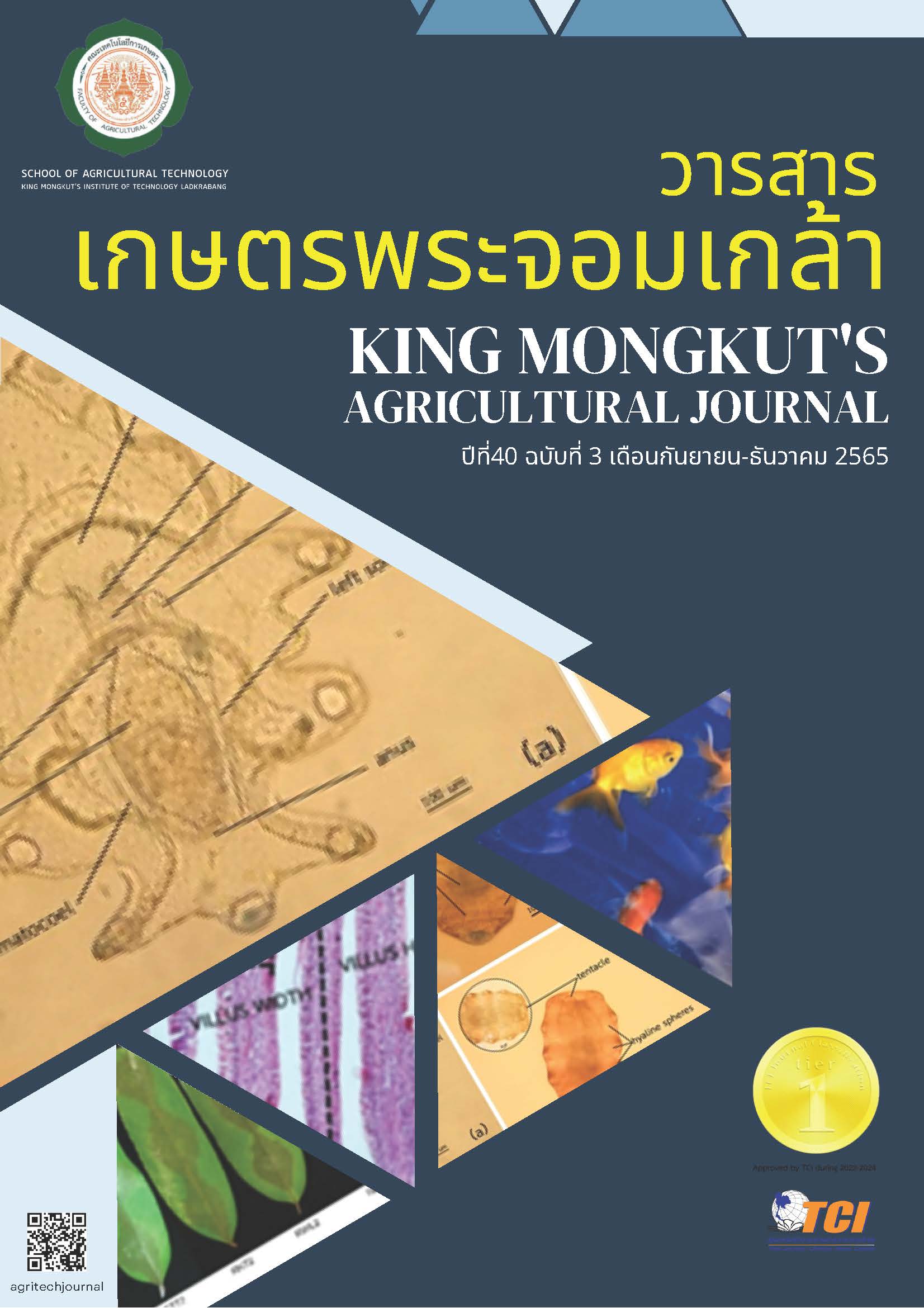การใช้เศษเหลือเครื่องในสัตว์ปีกเป็นแหล่งโปรตีนทดแทนปลาป่นในอาหารไก่ไข่ต่อสมรรถภาพการผลิตและคุณภาพไข่
Main Article Content
บทคัดย่อ
เศษเหลือเครื่องในสัตว์ปีก (Poultry offal waste; POW) จากการชำแหละสัตว์ปีก มีโปรตีนและไขมันสูง แต่ก่อให้เกิดปัญหามลภาวะต่อชุมชน การวิจัยนี้จึงมีวัตถุประสงค์เพื่อหาระดับที่เหมาะสมของการใช้ POW เป็นแหล่งโปรตีนทดแทนปลาป่น (FM) ในอาหารไก่ไข่ โดยใช้ไก่ไข่พันธุ์ไฮไลน์บราวน์ อายุ 48 สัปดาห์ จำนวน 600 ตัว แบ่งออกเป็น 5 กลุ่มๆ ละ 3 ซ้ำๆ ละ 40 ตัว เลี้ยงในกรงตับแบบบรรจุ 4 ตัว/กรง ซึ่งอยู่ในโรงเรือนปิด ด้วยระบบ Evaporative cooling system ไก่แต่ละกลุ่มได้รับอาหารที่มี POW ทดแทน FM ในสูตรอาหารระดับ 0, 25, 50, 75 และ 100% โดยทุกสูตรมีการปรับโปรตีนให้เท่ากันที่ 16% ส่วน ME มีปริมาณสูงขึ้นตามระดับการใช้ POW การทดลองใช้แผน Completely randomized design ทดลองเป็นเวลา 24 สัปดาห์ ปรากฏว่า POW ที่ได้จากโรงงานชำแหละไก่เนื้อในจังหวัดเชียงใหม่ เมื่อนำไปนึ่งภายใต้แรงดันที่ 30 psi อุณหภูมิ 135o ซ เป็นเวลา 5 นาที แล้วนำมาอบให้แห้ง มีโปรตีน ไขมัน เยื่อใย และเถ้า เท่ากับ 66.10, 24.80, 0.37 และ 5.19% of air dry ตามลำดับ ซึ่งพบว่ามีโปรตีนและไขมันสูงกว่า แต่มีเถ้าต่ำกว่า FM เมื่อนำ POW ไปใช้ทดแทน FM ที่ระดับ 75 และ 100% มีผลทำให้ผลผลิตไข่ คุณภาพไข่ด้านความหนาและความแข็งแกร่งของเปลือกไข่ด้อยลง ในขณะที่น้ำหนักไข่ และต้นทุนค่าอาหารต่อการผลิตไข่ สูงขึ้นอย่างมีนัยสำคัญเมื่อเทียบกับกลุ่มควบคุม (P<0.05) โดยสรุป POW สามารถใช้ทดแทน FM ในอาหารไก่ไข่ระยะก่อนปลดระวางได้สูงสุดที่ระดับ 50% โดยไม่มีผลเสียต่อต้นทุนการผลิต คุณภาพไข่ และการให้ ผลผลิตไข่
Article Details

อนุญาตภายใต้เงื่อนไข Creative Commons Attribution-NonCommercial-NoDerivatives 4.0 International License.
วารสารเกษตรพระจอมเกล้า
เอกสารอ้างอิง
A.O.A.C, (1990). Official Methods of Analysis. 15th edition. Association of Official Analytical Chemists, Washington, DC. Retrieved from
https://law.resource.org/pub/us/cfr/ibr/002/aoac.methods.1.1990.pdf Çayan, H., & Şahin, A. (2021). Laying hens behave as omnivores with poultry meal included in their diet. South African Journal of Animal
Science. 51(3), 280-289. Doi: 10.4314/sajas.v51i3.1. Department of Industrial Works. (2012). khūmư̄ kānčhatkān singwǣtlō̜m samrap ʻutsāhakam kānphalit plā pon [Environmental
Management Manual for Fishmeal Production Industry] 1sted. Bangkok: Department of Industrial Works.Retrieved from
http://php.diw.go.th/sns/sub_manual.php. Gümüş, E. & Aydin, B. (2013). Effect of poultry by-product meal on growth performance and fatty acid composition of carp (Cyprinuscar-
pio) fry. Turkish Journal of Fisheries and Aquatic Sciences. 13, 827-834. Doi: 10.4194/1303-2712-v13_5_06. Hosseinzadeh, M. H., Ebrahimnezhad, Y., Janmohammadi, H., Ahmadzadeh, A. R., & Sarikhan, M. (2010). Poultry byproduct meal:
Influence on performance and egg quality traits of layers. International Journal of Agriculture and Biology. 12, 547–550.
Retrieved from http://www.fspublishers.org/published_papers/18806_..pdf . Jackson, N. & Fulton, R. B. (1971). Composition of feather and offal meal and its value as a protein supplement in the diet of broilers.
Journal of the Science of Food and Agriculture. 22(1), 38-42. Doi: 10.1002/jsfa.2740220112.
Lokaewmanee, K., Pramul, A. & Kotmanee, A. (2016). phon khō̜ng kān sœ̄m dō̜kthō̜ng kwā wō̜ phong nai ʻāhān kai khai tō̜samatphāp
kānphalit læ khunnaphāp khai [Effect of butea monosperma (lam.) taub flower powder supplementation in layer diet on
egg production and egg quality]. King Mongkut's Agricultural Journal. 34 (3), 86-95.Retrieved from https://li01.tcithaijo
.org/index.php/agritechjournal/article/view/180991/128421. March, B. E. & Macmillan, C. (1990). Linoleic acid as a mediator of egg size. Poultry Science. 69 (4), 634-639. Doi: 10.3382/ps.0690634. Mbajiorgu, C. A., Hgambi, J. W. & Norris, D. (2011). Effect of varying dietary energy to protein ratio level on growth and productivity of
indigenous venda chickens. Asian Journal of Animal and Veterinary Advances. 6(4), 344-352. Doi: 10.3923/ajava.
344.352.
Ologhobo, A. D., Asafa, A. R. & Adejumo, I. O. (2012). Performance characteristics of broiler chicken fed poultry offal meal. International
Journal of AgriScience. 2(11),1021-1025. Retrieved from https://www.cabdirect.org/cabdirect/abstract/20123377825.
Olugbemi, T. S., Mutayoba, S. K., & Lekule, F. P. (2010). Evaluation of moringa oleifera leaf meal inclusion in cassava chip based diets fed
to laying birds. Livestock Research for Rural Development. 22 (6), 118. Retrieved from https://www.lrrd.cipav. org. co/
lrrd22/6/olug22118.htm.
Plaipetch, P. (2014). kān thǣn thī plā pon dūai kai pon læ nư̄a læ kradūk pon nai sūt ʻāhān plāka phong khāo [Dietary fishmeal
replacement with poultry by-product meal and meat and bone meal for asian sea bass].Thai Fisheries Gazette. 69(4), 351-
Retrieved from https://www4.fisheries.go.th/local/file_document/20170418143947_file.pdf.
Potter, D. K. & Fuller, M. F. (1967). The nutritional value of poultry offal meal in chick diets. Poultry Science. 46, 255-257. Doi: 10.3382/
ps.0460255.
Ravindran, V. & Blair, R. (1993). Feed resources for poultry production in Asia and the Pacific. III. Animal protein sources. World’s
Poultry Science Journal. 49(3), 219-235. Doi: 10.1079/WPS19930020.
Sahraei, M., Lootfollahian, H., & Ghanbari, A. (2012). Effect of poultry by product meal on performance parameters, serum uric acid
concentration and carcass characteristics. Iranian Journal of Applied Ani mal Science. 2(1), 73-77. Retrieved from https://
www.sid.ir/en/Journal/ViewPaper.aspx?ID=268665.
Salami, R. I. (1997). Replacement value of poultry visceral offal meal for fish meal in layers' diets. Nigerian Journal of Animal Production.
(1), 37-42. Doi: 10.51791/njap.v24i1.2348.
Samli, H. E., Senkoylu, N., Ozduven, M. L., Akyurek, H., & Agma, A. (2006). Effects of poultry by product meal on laying performance egg
quality and storage stability. Pakistan Journal of Nutrition. 5(1), 06-09. Retrieved from https://citeseerx.ist.psu.edu/view
doc/download?doi=10.1.1.505.175&rep=rep1&type=pdf.
Senkoylu, N., Samli, H. E., Akyurek, H., Agma, A., & Yasar, S. (2005). Performance and egg characteristics of laying hens fed diets
incorporated with poultry by-product and feather meals. Journal of Applied Poultry Research. 14, 542–547.Doi:
1093/japr/14.3.542.
Srikijkasemwat, K., Klompanya, A., & Suksupath, K. (2016). kānpramœ̄n khunnaphāp læ kān trūatkān plō̜mpon nai plā pon thī chai nai
ʻutsāhakam kānlīang sat [Quality evaluation and contamination testing in the fish meal used for livestock production
industry].Journal of Mahanakorn Veterinary Medicine, 11(2), 91-100. Retrieved from https://li01.tci-thaijo.org/index.Php
/jmvm/article/view/133900.
Tangtaweewipat, S. & Cheva-Isarakul, B. (1991). kānchai malet thāntawan radap sūng nai ʻāhān kai khai [ The use of high levels of sun-
flower seed in layer diets]. Journal of Agriculture. 7(3), 275-288. Retrieved from https://li01.tci-thaijo.org/index.php/
joacmu/article/view/247695.
Udedibie, A. B. I., Anyanwu, G., Ukpai, U. I. & Oyet, A. J. (1988). Poultry offal meal as protein supplement for laying hen and finisher
broilers. Nigerian Journal of Animal Production. 15, 103-109. Doi: 10.51791/njap.v15i.1217.


